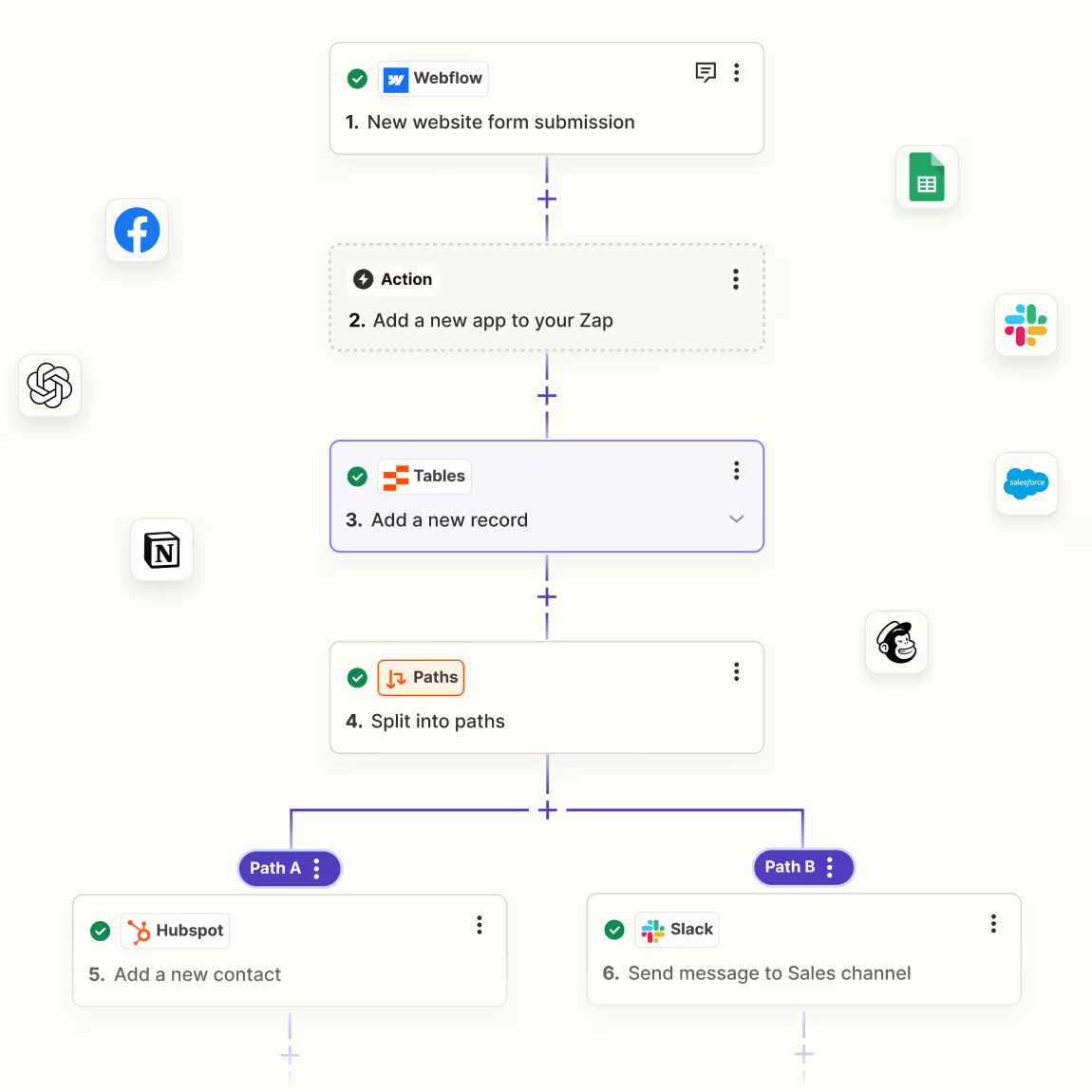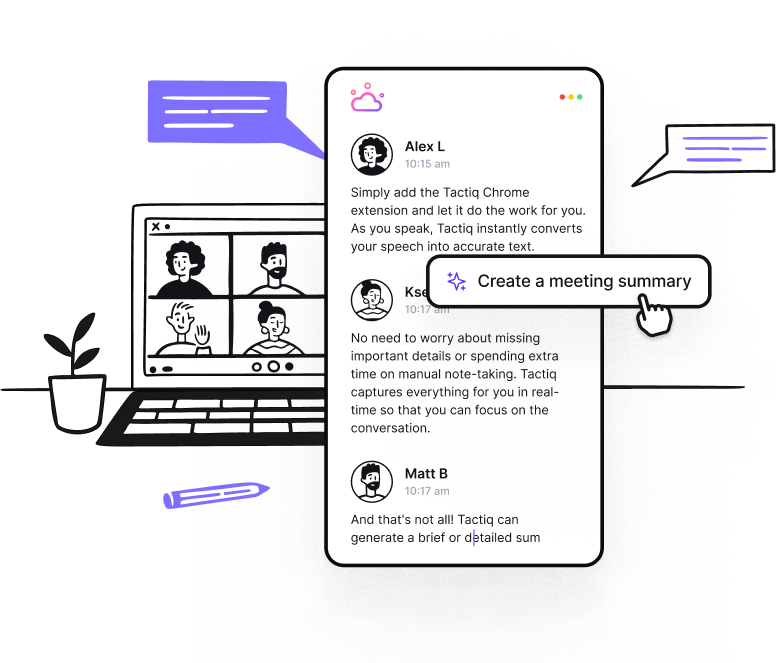AI Workflow Basics: What It Is & How to Get Started
November 15, 2024
November 15, 2024
June 12, 2025
June 12, 2025
Are you curious about how AI can fit into your daily workflows? AI workflow automation can simplify repetitive tasks. Imagine automatically transcribing meetings, organizing notes, or creating summaries without lifting a finger. AI workflow automation tools make these processes smoother.
In this guide, you’ll learn AI workflow basics, explore what it is, and break down the steps you need to get started.
What is AI Workflow Automation?
AI-powered workflow automation uses artificial intelligence to handle routine tasks. Here are a few tools that illustrate how AI-driven workflows can support different needs:

Image from Zapier
- Zapier - Known for connecting apps and automating workflows, Zapier lets users set up automated “Zaps” to trigger actions across platforms. For instance, you could automatically save email attachments from Gmail to Google Drive and then notify team members in Slack about the new file.
- UiPath - UiPath is a leader in robotic process automation (RPA). In finance, for example, it can pull data from invoices, input information into accounting software, and generate reports.
- HubSpot - For marketing and sales automation, HubSpot helps users automate lead management, email campaigns, and customer follow-ups. When a lead fills out a form, HubSpot can segment it, initiate a follow-up email, and schedule future reminders based on their behavior.
- Notion AI - Notion’s AI-powered features assist with task management and content creation. For example, users can set up templates for meeting agendas, and it can summarize key points or organize tasks.
Each tool demonstrates how AI workflow automation can save time, maintain consistency, and reduce manual workloads across different functions.
Benefits of Using AI Workflows
Time-Saving
AI workflows save valuable time that would otherwise be spent on manual processes. For example, instead of manually sorting through hours of recorded meetings, an AI tool can transcribe the meeting and generate a summarized report in minutes. This allows team members to focus on more strategic work, like planning projects or engaging with clients.
Consistency
Manual tasks are prone to inconsistency and human error, but AI workflows always complete tasks the same way. For instance, an AI system in customer service can standardize follow-up emails or responses that align with the brand's tone and quality. This is beneficial in large teams where maintaining a unified approach is crucial.
Improved Focus
Instead of organizing meeting notes or updating task lists, team members can focus on innovation and problem-solving. For example, AI could automatically update project management tools with recent meeting highlights.
Data-Driven Insights
AI workflows execute tasks and gather valuable data along the way. For instance, an AI tool that transcribes and categorizes customer feedback can help managers identify common trends or issues that need addressing. This data-driven insight enables teams to respond proactively, like adjusting customer support practices based on recurring feedback patterns.
Scalability
As businesses grow, AI tools can handle increasing workloads without additional resources. This scalable workflow keeps large teams organized, even as project demands increase.
4 Stages of AI
Understanding the stages of AI is important for implementing AI workflow automation successfully. Each stage plays a distinct role, helping to move from data collection to automated actions. Here’s a deeper look at each stage with examples of how they might play out in a real-world setting:
Data Collection
AI workflows start with data. Data could be anything, from customer survey results to purchase history, or even meeting transcripts. In the case of a meeting workflow, data collection might involve recording audio, capturing chat messages, or gathering real-time notes from a virtual meeting. The quality of data collected at this stage is critical because it helps generate accurate and useful AI insights later on.
For example, in customer support, data collection might involve gathering user queries, complaints, and feedback from various channels such as emails, chatbots, and social media. This collected data will later be used to identify patterns or common issues.
Data Processing
In data processing, AI algorithms sort, categorize, and prepare data by filtering out irrelevant or duplicate information (noise) and structuring it for analysis. This step ensures that the AI has access to accurate and relevant data.
For example, in a retail environment, raw sales data may need to be sorted by factors like region, product category, and time of purchase. By structuring the data effectively, AI can later analyze purchasing trends, seasonal demand, or customer preferences. This preparation stage ensures that AI has a reliable data set.
Analysis and Decision-Making
At this stage, AI algorithms analyze the processed data to identify patterns, trends, or correlations. This stage involves the AI “learning” from the data to make decisions or generate insights.
In customer support, this stage might mean analyzing the categorized support requests to identify common complaints or frequently asked questions. AI could reveal that customers often struggle with a particular product feature, prompting the support team to create resources or training that address this issue specifically.
Action and Automation
In the final stage, AI takes action based on the insights generated in the analysis stage. This is where automation allows the workflow to run independently and complete tasks without manual input. For a meeting workflow, this could mean automatically sending a summary to all participants, updating task lists based on action items discussed, or generating follow-up emails to ensure that decisions made in the meeting are acted upon.
For example, in marketing, AI can automatically segment customers based on past purchasing behavior and send personalized offers. Similarly, in project management, AI might set up task reminders and deadlines based on meeting notes to keep everyone aligned on responsibilities.
Each stage of AI workflow automation builds on the previous one, creating a cycle where data collection leads to actionable outcomes. Understanding these stages can help you implement AI workflows that support your goals and improve business processes.
How to Get Started with AI Workflows
Starting with AI workflows is not as complex as it sounds. Here's how you can begin:
Identify Repetitive Tasks
Start by listing out tasks you perform regularly that are time-consuming or repetitive. Look for opportunities to automate tasks like meeting transcription, follow-ups, or task management.
Choose the Right AI Workflow Tools

Select AI workflow automation tools that suit your needs. For instance, if you're looking to automate meeting workflows, consider using Tactiq for real-time transcription, AI-generated summaries, and action item automation.
Set Up Workflow Triggers
Define what will trigger the AI workflow to start. Triggers can include time, events, or specific actions that initiate automation.
Customize Your Workflows
Tailor your AI workflows to meet specific needs. Adjust settings for language, meeting type, or data analysis preferences so AI can provide relevant results. Customizable workflows make it easy to align automation with your goals.
Test and Optimize
Run a few test workflows to see how well they function. Make adjustments as needed to improve accuracy, timing, or output. Testing your workflows regularly ensures they continue to meet your evolving needs.
{{rt_cta_ai-convenience}}
How to Automate Meeting Workflows with Tactiq

If you’re ready to apply AI workflow automation to your meetings, Tactiq offers a way to simplify this process. Tactiq can transcribe your virtual meetings across platforms like Zoom, Google Meet, and MS Teams.
Key Features
- Tactiq automatically transcribes your meetings in real time, capturing every detail without taking manual notes.
- Use AI-generated summaries to capture meeting highlights, action items, and decisions for a quick, organized recap.
- Submit custom questions directly within transcripts to gain personalized insights and understand key points more clearly.
- Automate post-meeting tasks like generating follow-up emails, task lists, or project updates using custom AI prompts, helping you save time on routine tasks.
With Tactiq, you can keep track of tasks effortlessly and improve workflow efficiency.
An AI workflow is a series of automated steps powered by artificial intelligence that handle repetitive tasks, helping streamline processes. It collects data, analyzes it, and performs actions based on that analysis to improve productivity.
The four stages of AI are data collection, data processing, analysis and decision-making, and action and automation. Each stage is essential to ensure accurate insights and effective automated actions.
An AI ML (Machine Learning) workflow involves using machine learning models to analyze data, identify patterns, and make predictions or decisions, integrating automated processes to streamline tasks.
To automate a process with AI, identify routine tasks, choose an AI automation tool suited for those tasks, set triggers for actions, and integrate it with other tools to complete the workflow without manual effort.
With Tactiq, you can automatically transcribe meetings in real time, generate AI-powered summaries, and automate follow-up tasks like emails or action lists. This saves you time and ensures you never miss important details from your meetings.
Want the convenience of AI summaries?
Try Tactiq for your upcoming meeting.
Want the convenience of AI summaries?
Try Tactiq for your upcoming meeting.
Want the convenience of AI summaries?
Try Tactiq for your upcoming meeting.









